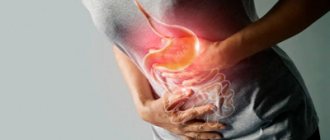Vomiting is a sign of pathology, a painful process occurring inside the body. Where vomiting itself plays the role of a natural protective mechanism that removes toxic substances from the gastrointestinal tract or protects it from excessive stretching. A single vomit is not a cause for panic if it is associated with pregnancy, seasickness, irritation or a foreign body in the throat. In case of severe, repeated attacks, regardless of the reasons that caused them, it is necessary to urgently seek the help of doctors. Especially with paroxysms of vomiting in children with a clearly unhealthy color of discharge.
Vomit color
Every adult has experienced normal vomiting at least once in their life and can imagine what it should look like. Vomit is a relatively light liquid mass with remnants of undigested food, which has a characteristic sour and pungent odor. If you eat a stale product, get sick with an acute viral infection, or get carried away with alcohol at a holiday party, your internal protective mechanisms will quickly respond by removing toxic substances. Vomiting is usually preceded by attacks of nausea, pain in the stomach and head, which disappear after the vomit is released. In some situations, the color of vomit turns into more saturated shades - from yellow-green to dark brown.
Why does it change?
Changes in the color of vomit depends on both internal and external factors. The reasons are physiological and pathological. The color and composition of vomit largely help in determining the causes of its occurrence.
Significant darkening of the vomit, even black, often indicates the development of internal bleeding. Penetrating into the gastric cavity, blood enters an aggressive environment - gastric juice saturated with enzymes and hydrochloric acid. Gradually accumulating, participating in the chemical processes occurring in the stomach, the blood coagulates, changing color to brown. When there is too much of it, it becomes an independent cause of the gag reflex - gastric contents are ejected through the mouth.
What colors are there?
- Yellow or green color.
- A change in the color of vomit towards yellow-green hues indicates an increased content of bilirubin in the blood, or bile directly entering the stomach cavity.
- Scarlet, purple, burgundy.
- The coloring of vomit in rich bright red colors clearly indicates gastric bleeding. Sometimes small spots of blood appear due to stomach spasms.
- Dark colors. Dark brown coloring of vomit is quite rare. It may occur due to food eaten the day before or be a consequence of internal bleeding. That is, have a physiological or pathological origin.
How to stop black vomit at home
If black vomit catches a person at an inconvenient time of day, at home or somewhere on the road, and there is no opportunity to go to the local hospital department soon, you should do the following as soon as possible:
- Still mineral water is good for rinsing the stomach. If the person who drinks alcohol does not have one nearby, you can use boiled water.
- Under no circumstances should vomit enter the respiratory tract. To do this, during the urge to vomit, it is better to sit down or lie on your side - this will make the unpleasant process much easier.
- You can take medications to stop vomiting. True, it is not advisable to do this without consulting a doctor. An example of such a medicine is cemural.
- Decoctions of anti-inflammatory herbs are a good way to stop or mitigate vomiting.
- If the vomiting has already passed, you should not eat food or take medications until you visit a doctor. It's best to get some sleep.
First aid
If black vomit appears, medical help is needed
If you see a person vomiting black in color, you need to help him. As mentioned earlier, this color of vomit indicates a rather serious condition of the victim.
Let's start with the fact that most likely he is still intoxicated, so he will probably not be able to correctly assess the seriousness of the situation. In this case, it is necessary to act persistently, while simultaneously trying to give instructions to the victim.
- Place the victim on a stable, hard surface. You can lie on your back or side. Of course, it is best to lie on one side - this way a person can avoid unnecessary movements during the next urge to vomit.
- Make sure that the person with symptoms of vomiting coffee grounds is lying comfortably. Pay attention to the belts the victim is wearing. Remove or loosen them as much as possible so that they do not put pressure on the stomach.
- Do not give any medications to the victim until the ambulance arrives.
- To slightly improve or at least alleviate the victim’s condition, make a cold compress for him - for example, wrap ice in some clothes or a towel. Afterwards, apply it to the patient's stomach.
- Make sure that the victim does not eat or drink - any intake of food or liquid can worsen the person's condition or even be fatal for him.
- Constantly monitor the victim: a person unconscious or intoxicated may not understand what is happening and simply choke on vomit or undigested food in it.
Physiological reasons
Vomiting of a brown tint, without signs of elevated temperature, is based on physiological reasons. Usually the color change occurs due to foods or medications.
In children
A vomiting attack with black or brown gastric contents in children can occur against the backdrop of the most innocent circumstances:
- the baby swallowed a drop of blood from the cracked nipple of the mother's breast while feeding;
- the child has eaten too many chocolates;
- before the attack, I ate bananas, which turn black very quickly in the stomach under the influence of gastric juice;
- homemade black pudding and carbonated Coca-Cola also stain the contents of the stomach;
- parents “fed” (for prevention purposes) activated carbon.
If the baby’s condition is stable after a vomiting attack, and there are no other pathological manifestations, we can confidently assume that the child simply overate, and the vomiting was a defensive reaction.
In adults
Coloring of vomit in adults is also caused by foods eaten (dark blueberries, blackberries, currants, beets, chocolate, coffee). However, much more often it is a pathological sign. Blood digested in the stomach takes on the appearance of a homogeneous mass, reminiscent of the remains of ground coffee. If the condition worsens and there are frequent relapses, you should immediately seek medical help.
Help for the victim
If dark-colored gastric secretions occur due to foods, it is recommended to exclude them from the diet. Do not use medications that cause dark vomit. If vomiting occurs once, and the body temperature does not increase, a number of actions should be taken:
- Rinse the stomach. Dissolve four to five granules of potassium permanganate in a liter of boiled, cooled water. Drink in large sips. If vomiting does not occur, induce using your fingers by pressing on the root of the tongue.
- To avoid dehydration, stir a sachet of Regidron in a liter of water. The drug helps restore water and electrolyte balance. Divide the content into five steps.
- Place the victim on his right side.
- Provide peace.
- Turn your head to the left or right side so that vomit does not interfere with respiratory activity.
- Avoid eating while vomiting.
Pathological causes of dark brown vomiting
Frequently repeated vomiting attacks of abnormal color indicate the development or exacerbation of serious diseases and require medical action. Among the pathological causes of brown vomiting, it should be noted:
- the presence of ulcerative formations in the gastrointestinal tract;
- development of malignant neoplasms in the gastrointestinal tract;
- erosive processes in the intestines, formation of polyps;
- diseases with liver failure and circulatory disorders;
- varicose veins in the esophagus: in almost all patients with cirrhosis of the liver;
- alcoholic beverages, toxic substances and drugs;
- fish bones, pieces from shells, shells of marine mammals, seeds from fruits, berries, etc.
If vomiting occurs with the formation of foam, the possibility of bleeding from the lungs cannot be ruled out. Vomit may turn brown due to medications:
- pharmaceutical preparations containing drugs;
- non-steroidal, anti-inflammatory drugs - “Indomethacin”, “Aspirin”, “Ibuprofen”;
- herbal medicinal infusions that provoke bleeding.
If you have any suspicions, it is best to seek the opinion of a doctor. To determine the root cause, he will consider all potentially valid options and draw a conclusion.
Causes of vomiting blood
Peptic ulcer
Vomit like “coffee grounds” is characteristic of massive bleeding from a damaged vessel at the bottom of the ulcer.
The dark color is due to the reaction of blood hemoglobin with hydrochloric acid of the stomach, which is accompanied by the formation of hematin hydrochloride. A few days before bloody vomiting, an increase in dyspeptic disorders and abdominal pain is noted. With the onset of bleeding, the pain subsides. The leading symptoms are caused by blood loss and hypoxia: the patient feels dizzy, weak, the skin and visible mucous membranes become pale. In the case of a single release of more than 50 ml of blood, it can enter the intestines, which is manifested by black stools (melena) the next day after vomiting “coffee grounds”. With blood loss of up to 15% of the blood volume, the general condition is of moderate severity, severe weakness, tachycardia, and a drop in blood pressure are observed. Complaints of dry mouth and severe thirst appear. With the loss of large volumes of blood, fainting, disturbances of consciousness are typical, and the pulse becomes thready.
Vomit, stained with scarlet blood, is the first symptom of most stress ulcers with intense gastroduodenal bleeding. Bloody vomiting occurs suddenly in the absence of pain in the epigastric region, which is associated with the predominance of symptoms of the underlying pathology. Weakness quickly increases, dizziness appears, the skin turns pale, and the pulse quickens. Bloody vomiting after night and morning “hungry” abdominal pain is also complicated by Zollinger-Ellison syndrome, in which multiple bleeding ulcerative defects of the gastric mucosa are formed.
Diseases of the gastroduodenal zone
Inflammatory processes, structural anomalies of the upper digestive tract and tumor formations can serve as predisposing factors for vomiting “coffee grounds”. The symptom occurs when the pathology is long-standing, when the mucous membrane is completely affected and the vessels are involved in the process. The difference from bleeding with ulcerative defects is the persistence of pain after vomiting. The causes of bloody vomiting are:
- Acute erosive gastritis
. Vomiting is preceded by moderate pain in the epigastric region, nausea, belching of air, and loss of appetite. With small hemorrhages, streaks of blood are found in the contents of the vomit; with extensive damage to the organ and massive bleeding, vomiting “coffee grounds” with black tarry stool (melena) begins. Similar symptoms are found in hyperplastic gastritis. - Hemorrhagic gastritis
. Inclusions of blood in vomit are characteristic of acute profuse bleeding. Vomiting develops against the background of pain in the epigastrium, which intensifies immediately after eating. Before the attack, severe nausea is felt for some time. With chronic blood loss, a metallic taste in the mouth, frequent dizziness, and shortness of breath when performing usual physical activity are possible. - Gastric diverticulum
. Bloody vomiting is a late sign of diverticulosis. This complication usually occurs when the disease persists for a long time and indicates an erosive process that damages the arteries. Before vomiting or simultaneously with it, a sharp pain is felt in the epigastrium. The next day, the stool usually becomes dark and tarry. - Acute gastric dilatation
. Repeated vomiting of gastric contents, and then masses mixed with bile and blood, begins after the sudden appearance of severe diffuse pain in the abdominal cavity and indomitable hiccups. More than 7-8 liters of vomit are released per day, while attacks occur spontaneously without the conscious efforts of the patient. There is gas retention and bloating. The condition is somewhat alleviated in the knee-elbow position. - Benign tumors
. Vomiting “coffee grounds” and melena are the first symptoms of massive bleeding in gastric leiomyoma, which, due to its slow progression, remains latent for a long time. Large bleeding polyps of the stomach are characterized by the presence of individual streaks of blood in the secreted vomit against the background of other dyspeptic disorders. - Erosive bulbitis
. Bloody vomiting indicates severe bleeding from an eroded vessel in the wall of the duodenal bulb. Due to significant blood loss, disturbances in general health are possible - weakness, pallor, fainting. Unlike most other pathologies, tarry stools often precede vomiting; less often, melena occurs after an attack.
Diseases of the esophagus
Esophageal pathology is accompanied by vomiting with the discharge of bright scarlet blood (hematemesis). The symptom is characteristic of inflammatory processes, in which the vulnerability of the mucous membrane increases, and superficial or deep defects are formed. Hematemesis is provoked by trauma to the wall of the esophagus by foreign bodies, iatrogenic damage during medical procedures. Among the main reasons for the development of symptoms are:
- Mallory-Weiss syndrome
. Bleeding is provoked by prolonged vomiting or hiccups, during which the smooth muscles of the gastrointestinal tract wall and the abdominal muscles are greatly strained. Against the background of the next urge to vomit, a sharp burning pain is felt in the area of the xiphoid process, after which profuse vomiting of blood begins. The symptom is also detected in cases of rupture of the esophagus of another etiology (burns, thoracoabdominal trauma). - Acute esophagitis.
The prerequisite for bleeding and vomiting is the formation of erosions or ulcers of the esophagus due to the protracted course of the inflammatory process. With the onset of the attack, sharp pains in the chest, typical for damage to the esophagus, intensify, occurring after eating and in a horizontal position. Signs of posthemorrhagic anemia appear - weakness, fatigue, dizziness. Before vomiting, belching of air, heartburn, and nausea are observed. - Hiatal hernia
. Vomiting blood is one of the signs of strangulation of the hernial sac. It occurs suddenly or against a background of nausea and is combined with sharp chest pain, which can radiate to the shoulder blades and neck. The patient's general condition is severe - shortness of breath is pronounced, the skin becomes cyanotic, the pulse quickens to 100 or more beats per minute, and blood pressure drops. - Perforation of the esophagus
. With a through defect of the organ wall, repeated vomiting with impurities of fresh blood is typical, then the vomit takes on the appearance of “coffee grounds.” Severe pain is noted, which in intensity resembles a myocardial infarction or perforation of a stomach ulcer. When air enters the cellular space of the mediastinum and neck, subcutaneous emphysema develops and breathing becomes difficult. - Tracheoesophageal fistula
. Bloody vomiting is provoked by the presence of an acquired anastomosis between the esophagus and trachea, which contributes to the destruction of the vessels of the mucous membrane. The symptom is often accompanied by breathing problems - coughing, suffocation, hemoptysis. The possible presence of a trioesophageal fistula as a cause of vomiting is indicated by moderate chest and epigastric pain, coughing up pieces of food, and a tendency to frequent diseases of the lungs and bronchi. - Esophageal carcinoma.
Vomiting usually occurs when the tumor is large and partially covers the lumen of the organ. The symptom is combined with difficulty swallowing solid food, a constant sensation of a foreign body (“lump”) behind the sternum, hoarseness, and a constant dry cough. The presence of blood streaks in the vomit is characteristic of the late stage of the disease with ulceration and disintegration of neoplasia.
Portal hypertension
The main cause of vomiting blood with increased pressure in the portal vein is varicose veins of the esophagus. These vessels have a specific feature: they do not collapse, so blood loss is abundant (up to 30-40% of the blood volume), which is life-threatening. Children may experience fountain vomiting with the release of bright red blood, which is an unfavorable prognostic sign. Portal hypertension with vomiting can be caused by pylephlebitis, congenital fibrosis of the liver, and structural anomalies of large venous vessels of the abdominal cavity.
Bleeding from the esophageal veins is characteristic of the decompensated stage of the disease. At the same time, in the initial stages of portal hypertension, nausea, periodic heartburn or belching, and stool disturbances are disturbing. As the pathological process progresses, patients notice swelling in the lower extremities, and an expanded venous network is clearly visible on the skin of the anterior abdominal wall. Dull pain is felt in the left hypochondrium, which is caused by an enlarged spleen.
Infectious diseases
Vomiting blood occurs in the hemorrhagic form of dengue fever or yellow fever. These viral infections affect the vascular wall and disrupt the blood coagulation system. Against the background of high fever and general infectious syndrome, uterine, nasal, and gastrointestinal bleeding occurs. Bloody vomiting can begin with the intestinal form of anthrax, in which case it is combined with melena, excruciating abdominal pain. The discharge of blood with vomit is typical for the initial period of the plague, which affects all organ systems.
Hemorrhagic syndromes
Regurgitation of vomit containing blood is a typical sign of gastrointestinal bleeding in hemorrhagic diathesis. More often, vomiting “coffee grounds” complicates the course of thrombocytopenic purpura and hemorrhagic vasculitis. In addition to dyspeptic disorders, such patients complain of a macular or papular rash on the limbs and torso. Massive nasal and intestinal bleeding, triggering the gag reflex, are pathognomonic for rare hereditary pathologies - Wiskott-Aldrich syndrome and Randu-Osler-Weber disease.
Acute conditions
In children, vomiting blood may be a sign of systemic intoxication due to extensive burns or neurotoxicosis. Such conditions, in addition to regurgitation, are characterized by an extremely serious condition of the child, disturbances of consciousness, and dysfunction of the cardiovascular and respiratory systems. Repeated bloody vomiting, detected on the second or third day of post-resuscitation illness, acute peritonitis, cardiogenic shock, indicates gastrointestinal bleeding due to the developed hemorrhagic syndrome.
Pathology of ENT organs
Vomiting of “coffee grounds” is observed with heavy nosebleeds, which are accompanied by ingestion of blood. This often results in dizziness, weakness, unpleasant taste in the mouth, and nausea. Massive blood loss provokes fainting, tachycardia, and severe pallor of the skin. The release of vomit in the form of “coffee grounds” is also characteristic of combined burns of the pharynx, which are combined with damage to the underlying parts of the gastrointestinal tract, ammonia poisoning (if ingested), causing destruction of the mucous membrane.
Complications of pharmacotherapy
Sometimes bloody vomiting is a consequence of gastrointestinal bleeding, provoked by so-called ulcerogenic drugs - drugs that contribute to the formation of erosive and ulcerative defects in the mucous membrane of the digestive organs. As a rule, patients report long-term, sometimes uncontrolled use or high dosage use of the following groups of medications:
- Non-steroidal anti-inflammatory drugs (NSAIDs)
: aspirin, indomethacin, butadione. - Glucocorticosteroids
: prednisolone, dexamethasone. - Direct oral anticoagulants
: dabigatran, apixaban, rivaroxaban. - Antigout drugs
: atophan, zinchofen. - Antihypertensive sympatholytics
: reserpine. - Psychostimulants
: caffeine, some narcotics (cocaine, methamphetamines).
Symptoms
The main symptom (and precursor) of gastric eruption is an attack of nausea and a reflexive urge to vomit. Other symptoms may appear at the same time.
Associated symptoms
Attacks of severe brown vomiting are usually accompanied by the following symptoms:
- aching headaches;
- thirst and dry mouth;
- pain in the abdominal area;
- belching and heartburn;
- cold sweat and trembling in the limbs;
- diarrhea or constipation.
Sometimes, with brown vomit, temperature fluctuations occur. Along with the appearance of blood clots and pus in the gastric secretions, this is a serious reason for urgently seeking medical help.
Signs indicating bleeding
In addition to vomiting attacks, the following signs indicate internal pathology with bloody nausea:
- apathetic state and attacks of weakness;
- pale skin;
- anemia, even blueness of the mucous membranes;
- uneven pulsation and “floating” pressure;
- feverish condition;
- darkening of feces;
- dizziness.
If bloody vomiting is particularly severe, a brief loss of consciousness may occur.
Symptomatic therapy
The appearance of blood in the contents of the stomach indicates serious diseases of the digestive system or other organs, so self-medication or delay in seeking medical help can be harmful to health. Patients with coffee-ground vomiting require rest and urgent hospitalization to determine the causes of the symptom and select a treatment regimen. At the preclinical stage, applying cold to the abdomen is acceptable. Intensive therapy is aimed at stopping bleeding and normalizing hemodynamic parameters.
Dangerous consequences
It is difficult to predict the consequences of gastric bleeding, especially with little blood loss. Mild but prolonged blood loss usually causes chronic posthemorrhagic anemia. A timely diagnosis with indicated treatment increases the chances of a favorable outcome.
Acute, heavy bleeding is fraught with the development of hemorrhagic shock. A sharp decrease in the volume of circulating blood flow provokes oxygen “starvation” and the development of acute hypoxia. This complication is critically dangerous and requires immediate assistance.
But that's not all. Excessive blood loss provokes the rapid development of renal failure. A terrible complication is caused by a sharp decrease in upper blood pressure to a level in which the function of the renal organs is impaired. They stop working normally. Young children and older people are most at risk.
Review of remedies for illness
If the cause of dark vomiting is a disease of the digestive organs, the patient is prescribed:
- Cerucal. The dosage ranges from 1 to 3 tablets or ampoules per day. Depends on the severity of the disease.
- Metoclopramide. Taking two tablets no more than four times a day or intramuscular injection of 20 mg no more than three times a day.
If black vomiting is caused by ethanol poisoning, the following drugs are prescribed:
- Atoxil, Sorbex, Polysorb, which are necessary to rid the gastrointestinal tract of toxins. They can stop not only vomiting, but also relieve loose stools.
- To stop vomiting and retching, raglan, cerucal or motilium are prescribed.
- Intravenous administration of Ringer's solution helps to avoid dehydration.
If black vomiting in an elderly person is caused by cancer, the doctor will prescribe the following medications:
- Polysorb, coal, sorbex. Indicated for intoxication of the body due to the disintegration of a malignant formation.
- Treatment with Ondansetron, Metoclopramide and Granisetron is necessary if gastric obstruction occurs or after chemotherapy.
- The administration of Olanzaline, Dexamethasone, and Quetialin is necessary when metastases appear.
- If the level of calcium in the body is elevated, treatment with Haloperidol is indicated.
Diagnostics
Since brown vomiting can be a sign of a dangerous disease, it is necessary to find out the causative factor of the pathology and quickly take action. Usually, the patient is hospitalized in the surgery department of the nearest medical facility. The doctor examines the patient and prescribes the necessary diagnostic procedures. The list of which includes:
- Examination of vomit to determine the type of toxins and possible source of bleeding.
- Endoluminal sonography procedure.
- Gastrointestinal endoscopy procedure.
- Using a special device with a micro video camera on a flexible hose, a gastroenterologist can examine and identify any pathological changes in the esophagus, stomach, and nearby parts of the intestine;
- Taking general tests (blood, urine, feces) to complete information about the patient’s condition.
After diagnostic procedures and establishing the cause of vomiting attacks, a course of complex treatment is prescribed.
Survey
To identify the causes of vomiting with blood, a gastroenterologist prescribes a comprehensive examination, which is aimed at studying the morphological and functional features of the gastrointestinal tract. Instrumental studies have high diagnostic value; laboratory tests help determine the severity of hemodynamic and metabolic disorders. The examination plan includes:
- Endoscopic methods
. To accurately determine the location of bleeding and visualize the defect in the mucous membrane of the upper gastrointestinal tract, an endoscopy is performed. If necessary, during the procedure, coagulation of the affected vessel is performed, and a biopsy is taken from pathologically changed areas of tissue. - X-ray examination
. X-rays with oral contrast are performed only after vomiting has stopped and the condition has stabilized. The method is informative for diagnosing organic changes and hernial formations. Contrast leakage beyond the lumen of the gastrointestinal tract indicates perforation or fistula tracts. - Sonography
. An abdominal ultrasound is prescribed to quickly assess the condition of the abdominal organs. Sonography is used to identify space-occupying formations in the gastrointestinal tract, hernias, and diagnose liver diseases. To assess linear blood flow in the hepatic and splenic veins, Doppler sonography is performed. - Laboratory methods
. A general blood test is necessary to determine the degree of blood loss and the severity of anemic syndrome. If hereditary defects in the hemostatic system are suspected, an extended coagulogram is performed with determination of prothrombin time and other coagulation parameters. Sometimes serological tests are prescribed.
For possible primary disorders in the vascular system, contrast angiography is performed; radioisotope scintigraphy is recommended to assess the condition of the liver parenchyma. Additionally, macro- and microscopic analysis of stool is performed; to exclude intestinal bleeding, the Gregersen reaction to occult blood is informative. If hematemesis is combined with signs of hemorrhagic diathesis or general infectious syndrome, consultation with other specialists is required.
Before arrival
First aid rules
If brown or black masses of vomit appear, caused by mild food poisoning, a person usually does not need an emergency call to the doctors. The pathology can be dealt with at home. However, it is still necessary to provide first aid to the victim:
- The patient is placed in a horizontal position with a container for vomit.
- Provide a comfortable position for the head so that it is lower than the lying body.
- They do not interfere with the emetic process - the body is freed from toxic toxins.
- After making sure that the stomach is empty, you can offer the patient activated carbon tablets or a solution of mint drops. The dose of the medicine depends on the person’s weight.
- In case of severe vomiting attacks, taking the antipsychotic drug “Aminazine” helps.
- For obvious pain in the epigastric region, you can give any painkiller.
Treatment of vomiting bile
Effective relief from attacks of bile vomiting depends entirely on successful treatment of the disease causing it.
Specialists at the Yauza Clinical Hospital will quickly identify the cause of the unpleasant symptom - vomiting bile. In a hospital setting, it is possible to carry out both conservative therapy and high-tech surgical treatment for most diseases that cause this unpleasant symptom.
You can see prices for services
Treatment for brown vomit
Having learned the cause of dark vomiting, the specialist prescribes a course of treatment - drug therapy or surgery. Conservative treatment is required for milder gastric dysfunctions, and to restore the functionality of the intestine when it is blocked, surgical intervention will be required.
To relieve vomiting attacks, a course of symptomatic therapy with drugs is carried out:
- "Cerucal"
- One tablet is taken before meals 3 times a day, or intramuscular injections are given;
- "Metoclopramide"
- According to the same scheme.
In severe conditions, the patient additionally:
- connect an oxygen cushion;
- give a blood transfusion;
- Prescribe drugs that normalize cardiac functions: “Mixiletin”;
- "Quinidine";
- "Etacizina."
After alcohol poisoning
In case of severe alcohol intoxication with repeated vomiting, a gastric lavage procedure is performed:
- The patient is "filled" with water to fill the stomach and provoke a gag reflex.
- Lay on the side, preventing vomit from entering the respiratory system.
- After clearing the gastric cavity of food debris and alcohol, sorbents are prescribed:
- "Smecty";
- "Atoxyla";
- "Polysorba".
- After an hour, antiemetic drugs are administered:
- "Motilium";
- "Zofran";
- "Raglan".
- To prevent the risk of dehydration, the patient is given a drip with Ringer's solution.
For cancer
For vomiting syndrome from cancer, doctors recommend the following:
- For gastric obstruction and after chemotherapy treatments:
- "Granisetron";
- "Emeseta";
- "Ondansetron".
- When a tumor disintegrates and releases large amounts of toxic substances:
- "Polysorb";
- "Smecty";
- activated carbon.
- With the development of tumor metastases:
- glucocorticoid hormone "Dexamethasone";
- neuroleptics Olanzapine and Risperidone.
- "Quetiapine" for the development of tumor metastases;
- "Haloperidol" for hypercalcemia.
Treatment
Help before diagnosis
The occurrence of fecal vomiting in a person is provoked by severe diseases with a high incidence of multiple organ failure and the risk of death, for which emergency medical care is indicated. To save the patient's life, it is critical to quickly determine why the disorder began. You cannot self-medicate, take antiemetics or painkillers, which can blur the clinical picture until the doctor arrives.
Conservative therapy
Drug therapy is prescribed regardless of the cause of vomiting of intestinal contents. Treatment is aimed at restoring circulating blood volume and electrolyte disturbances, reducing endogenous intoxication, and preparing the patient for surgery. To eliminate the expansion of intestinal loops, decompression is additionally performed by nasointestinal intubation. For fecal vomiting use:
- Infusion solutions
. Massive infusions of saline solutions (isotonic NaCl, Ringer's) are necessary for rehydration and replenishment of blood volume. For a stable effect, the drugs are combined with plasma-substituting colloidal solutions - rheopolyglucin, dextrans. - Antibiotics
. The reasons for the development of fecal vomiting often also lead to intestinal infarction and the addition of a bacterial infection. Therefore, to prevent it, broad-spectrum antibiotics are used in high therapeutic dosages. - Analgesics
. To eliminate severe pain, narcotic drugs are indicated and administered to prepare the patient for surgery. For the purpose of premedication, tranquilizers with sedative and weak analgesic effects are also recommended.
Surgery
If intestinal obstruction is diagnosed, laparotomy is usually performed, followed by exploration of the abdominal organs, dissection of adhesions, resection or elimination of the volvulus. Operations for peritonitis include revision, sanitation and other manipulations. If a non-viable section of the intestine is identified, it is resected and an anastomosis is formed. In case of a serious and threatening condition of the patient, they are limited to a colostomy with future surgery to restore the continuity of the intestinal tract.
Therapy for blood loss
If the color is brown, it is blood. Then, after diagnosing and fixing the source of bleeding, they begin therapy to stop and replace blood loss.
Bleeding is controlled with conservative drug therapy or surgical intervention. During drug treatment, hemostatic drugs are prescribed, for example aminocaproic acid, and agents that improve blood clotting. Then they move on to vasoconstrictor medications, for example, Dopamine.
An operation to stop bleeding is indicated in cases where the cause and source of development of the pathology are precisely established. It is usually performed using an endoscope. Thermal methods are used in the form of thermocoagulation and electrocoagulation methods, or mechanical methods - ligation, clipping of vascular lesions. If the endoscopic method is insufficiently effective, laparotomy surgery is performed. After stopping the bleeding, a planned intervention is prescribed, usually by emergency surgery.
To replenish blood loss, infusion therapy is used. Compensation solutions are selected depending on the amount of blood lost:
- With light currents and small losses:
- salt-based solutions such as Acesoli or a simple isotonic solution (saline);
- For average blood loss:
- saline solutions alternate with colloidal ones - “Gelatinol”, “Reopoliglyukin”, “Refortan”.
- With heavy blood loss:
- jet blood transfusions are prescribed. In particularly severe situations, IVs are placed in two veins at the same time, preventing possible cardiac failure.
How does pathology manifest itself in oncology?
The pathology is quite common as a complication of cancer of the stomach and esophagus. People over 55 years of age are most susceptible to it. One of the symptoms of the disease is sudden weight loss.
The main reasons are:
- Disintegration of the tumor focus;
- Ulceration of the tumor focus;
- Rupture of a vessel affected by the tumor;
- The process of suppuration, the development of vascular thrombosis and subsequent necrosis.
A very high proportion of the development of pathology occurs in patients with liver and pancreas cancer.
What consequences can you expect?
What awaits the victim with black vomit depends on how much blood was lost during gastric or intestinal hemorrhage. If a person has lost a small amount of blood, the consequence is a mild degree of anemia. If anemia is detected early and appropriate therapy is prescribed, health consequences can be avoided.
If the hemorrhage appears suddenly and a lot of blood is lost, this contributes to the occurrence of hemorrhagic shock. It is characterized by the appearance of pale skin and mucous membranes, rapid heartbeat and low blood pressure.
The internal organs are not supplied with the required amount of oxygen, which is transported by red blood cells. This develops severe hypoxia. Lack of oxygen requires medical attention.
With a large amount of blood lost, the risk of kidney failure increases. This is explained by the fact that the filtering of blood by the kidneys occurs if the required level of blood pressure is present. When pressure decreases, the kidneys stop functioning.
Home remedies for the problem
Vomiting black liquid, what it is and whether it can be dealt with at home, everyone who has encountered it will ask. Self-medication is allowed if the cause of vomiting is not a disease of the gastrointestinal tract or cancer. For food poisoning accompanied by dark discharge from the stomach, use:
- Two to three ripe peaches.
- Drink half a glass of red currant juice.
- Potato juice. To obtain juice, potatoes are grated or crushed in a blender, and the potato mass is squeezed through cheesecloth.
- Infusion of lemon zest and alcohol. Pour the peels of three lemons with half a glass of alcohol and 200 ml of water. Leave for three days in a dark place.











